Слайд 1The Word As The Basic Unit Of The Language
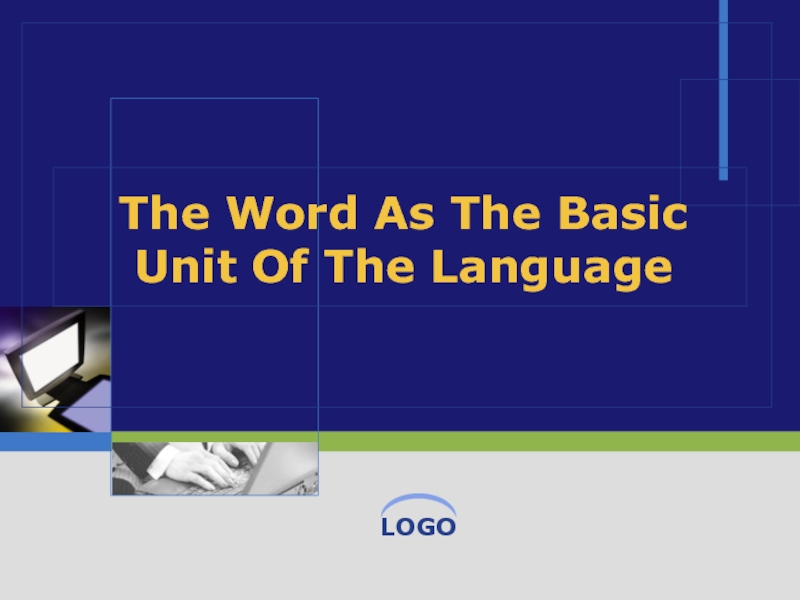
Слайд 2The word is a unit of speech that serves the
purposes of human communication.
The word can be perceived as
the total of the sounds which comprise it.
The word, viewed structurally, possesses several characteristics.
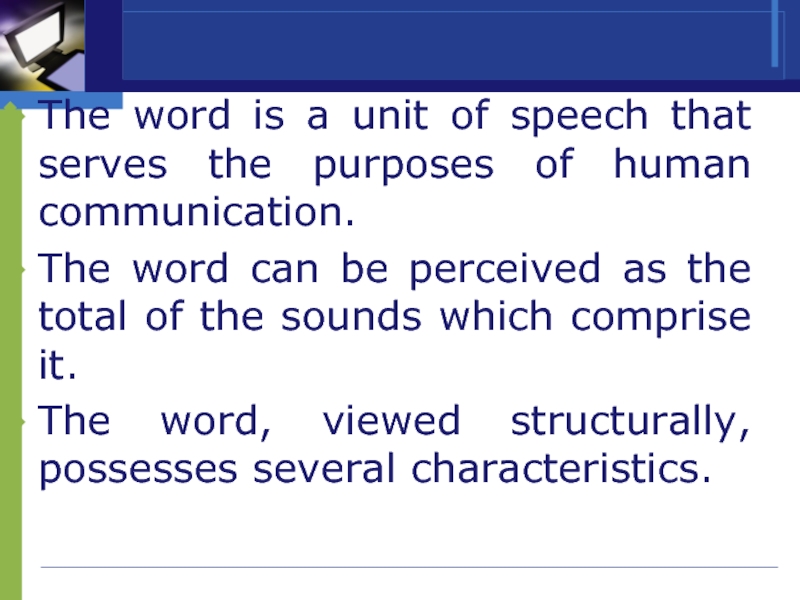
Слайд 3Word-meaning
Two schools:
the referential approach, which seeks to formulate the essence
of meaning by establishing the interdependence between words and the
things or concepts they denote
the functional approach, which studies the functions of a word in speech and is less concerned with what meaning is than with how it works
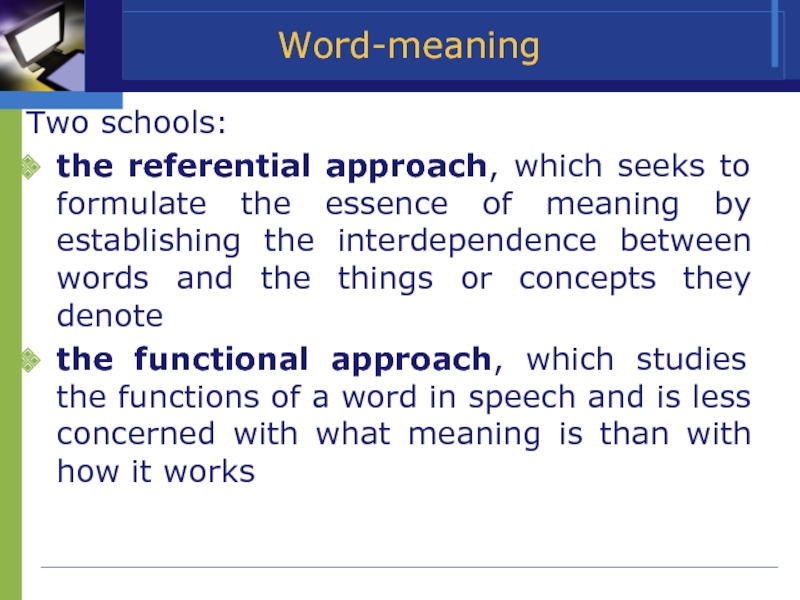
Слайд 5There is no inherent connection between this particular sound-cluster and
the meaning of the word.
English dove, Russian голубь
Seal – “a
piece of wax, lead”
Seal – “a sea animal”
O.E. lufian, Mn.E. love
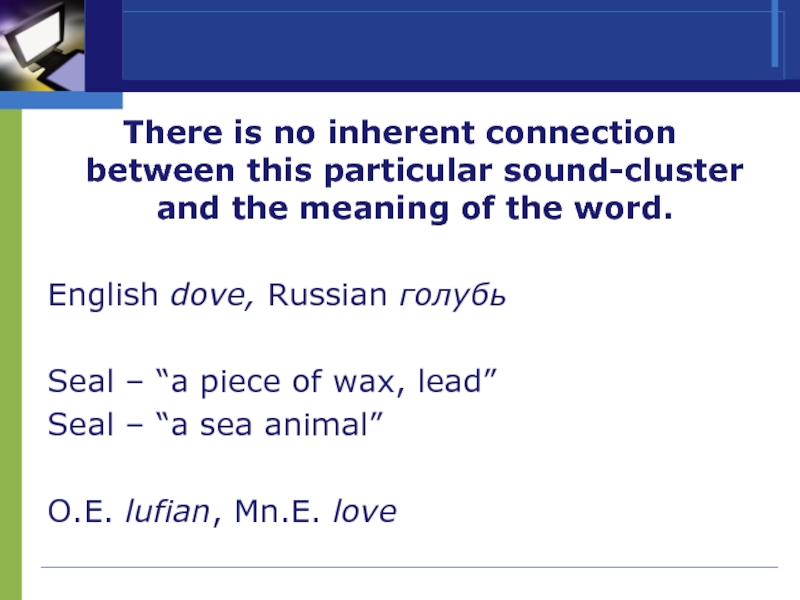
Слайд 6Concept is a category of human cognition. Concept is the
thought of the object that singles out its essential features.
Our concepts abstract and reflect the most common and typical features of the different objects and phenomena of the world. Being the result of abstraction and generalisation all concepts are almost the same for the whole of humanity in one and the same period of its historical development.
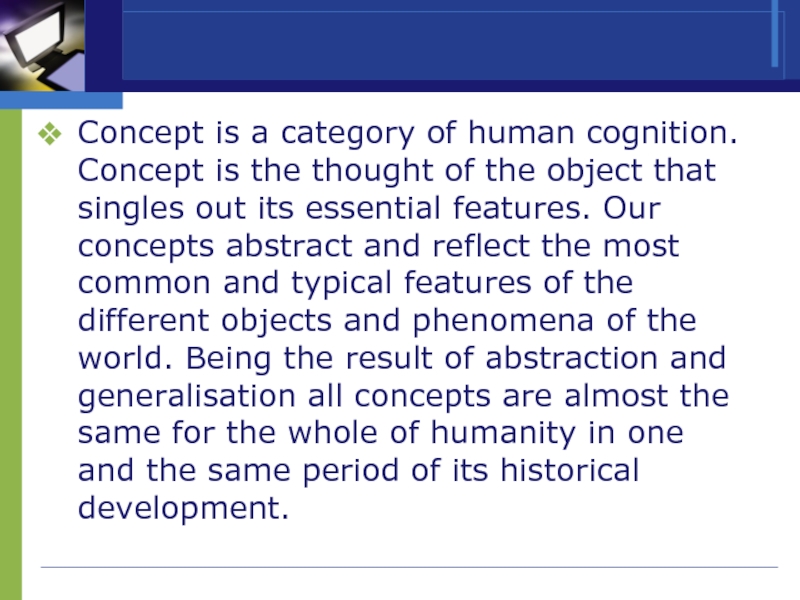
Слайд 9The structure of the word
External structure (morphological)
post-impressionists:
prefixes post-, im-
root
press
noun-forming suffixes -ion, -ist
grammatical suffix of plurality –s
Internal structure (semantic)
The
word’s meaning
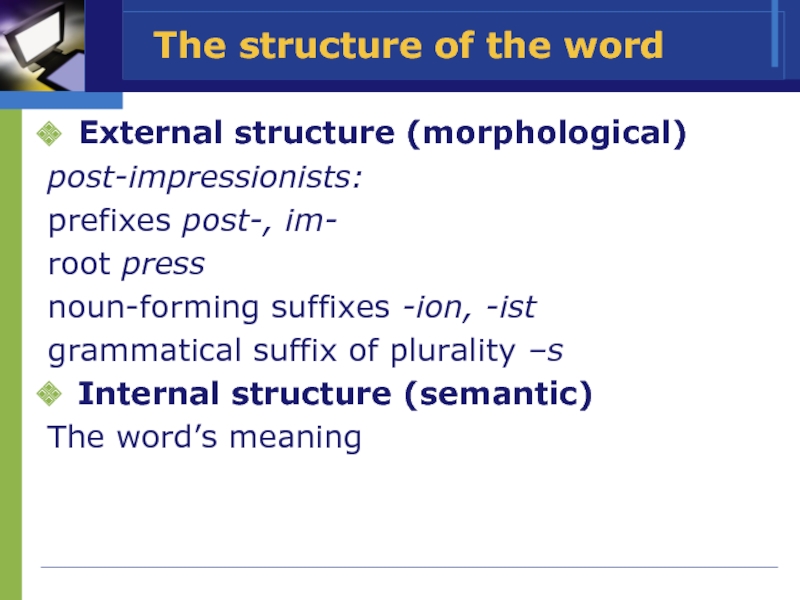
Слайд 11www.themegallery.com
Company Name
The Etymology of English Words
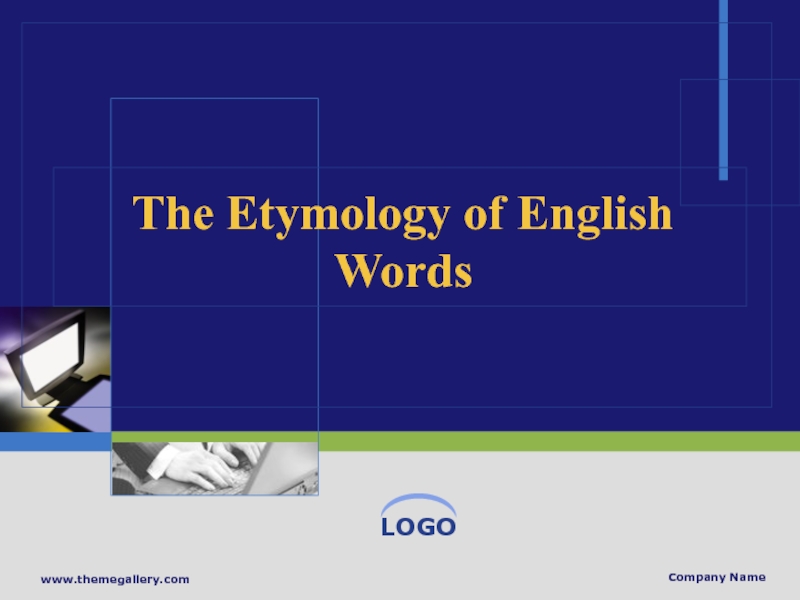
Слайд 12www.themegallery.com
Company Name
The first century В. С.
butter and cheese (Lat. butyrum,
caseus)
cherry (Lat. Cerasum)
pear (Lat. Pirum)
pepper (Lat. Piper)
plant (Lat. Planta)
cup
(Lat. cuppa)
kitchen (Lat. coquina)
port (Lat. portus)
wine (Lat. vinum)
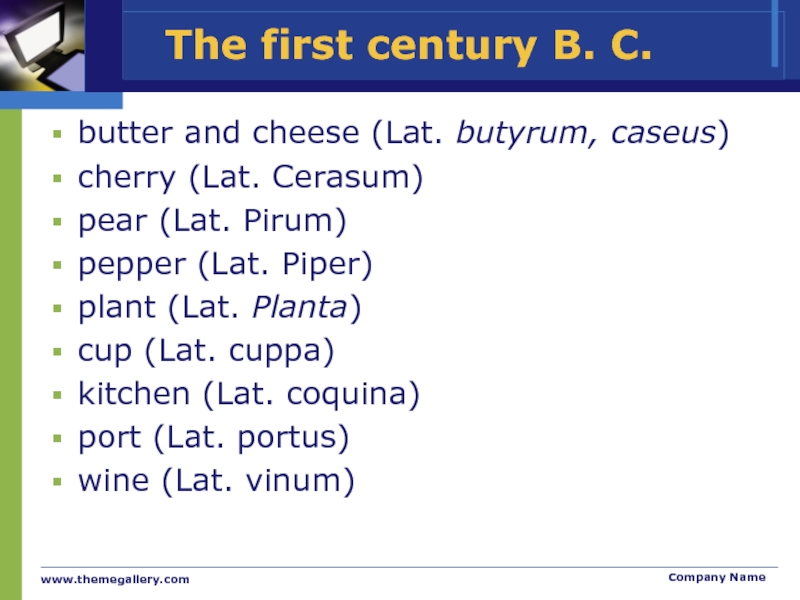
Слайд 13www.themegallery.com
Company Name
The fifth century A. D.
Mod. E. bald, down, glen,
druid, bard, cradle
Avon, Exe, Esk, Usk, Ux
Celtic Llyn
+ dun
Street (Lat. strata via)
Wall (Lat. Vallum)
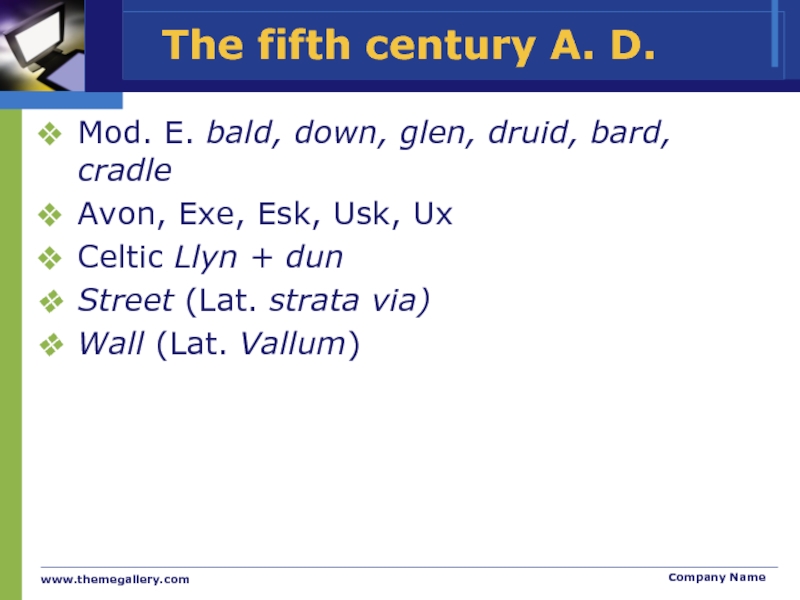
Слайд 14www.themegallery.com
Company Name
The seventh century A. D.
priest (Lat. presbyter)
bishop (Lat. Episcopus)
monk (Lat. monachus)
nun (Lat. nonna)
candle (Lat. candela)
school (Lat. schola, of
Greek origin)
magister (Lat. magister)
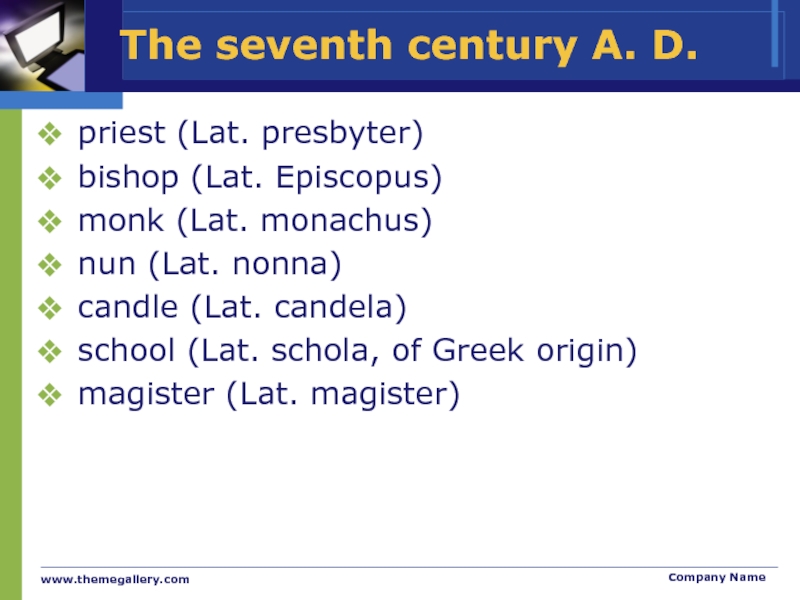
Слайд 15www.themegallery.com
Company Name
End of the 8th –middle of the 11th
Scandinavian
borrowings: call, take, cast, die, law
husband, (< Sc. hus +
bondi, i. e. «inhabitant of the house»), window (< Sc. vindauga, i. e. «the eye of the wind»)
ill, loose, low, weak
sky, skill, skin, ski, skirt
О. Е. dream (“joy”) – Scandinavian draumr (Germ. Traum «dream“, R. дрёма)
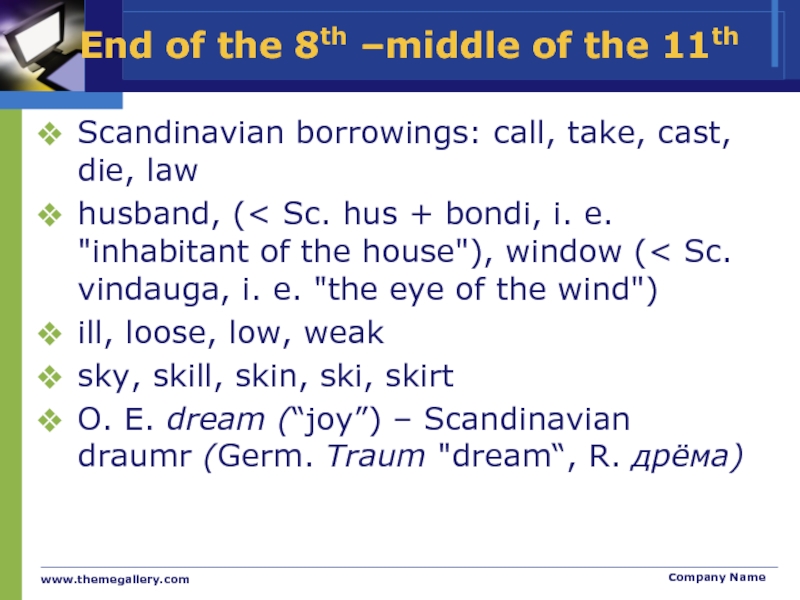
Слайд 16www.themegallery.com
Company Name
1066
Administrative words: state, government, parliament, council, power
Legal terms:
court, judge, justice, crime, prison
Military terms: army, war, soldier, officer,
battle, enemy
Educational terms: pupil, lesson, library, science, pen, pencil
table, plate, saucer, dinner, supper, river, autumn, uncle
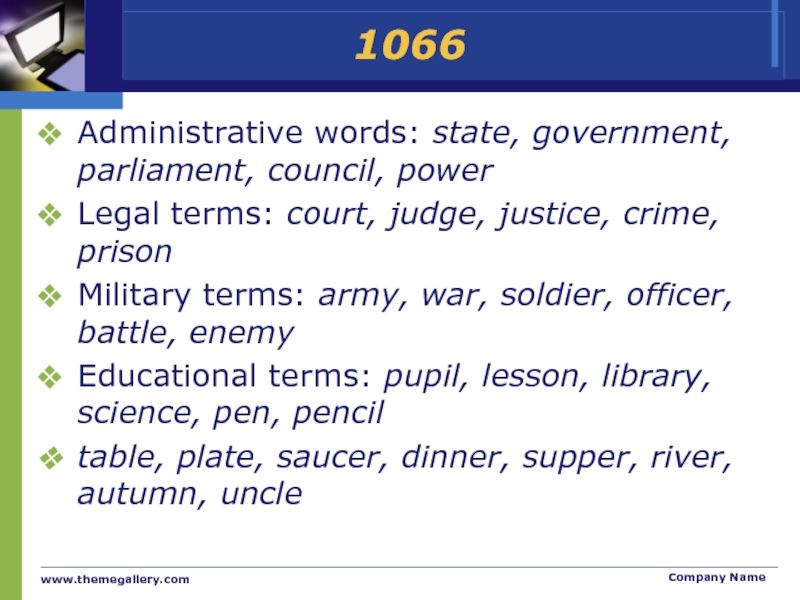
Слайд 17www.themegallery.com
Company Name
The Renaissance Period
abstract words (major, minor, intelligent, permanent,
to elect, to create)
scientific and artistic terms (status, phenomenon, philosophy,
method, music)
Greek Renaissance borrowings (atom, cycle, ethics, esthete)
Parisian borrowings (regime, routine, police, machine, ballet, scene, technique)
Italian (piano, violin, opera, alarm, colonel)
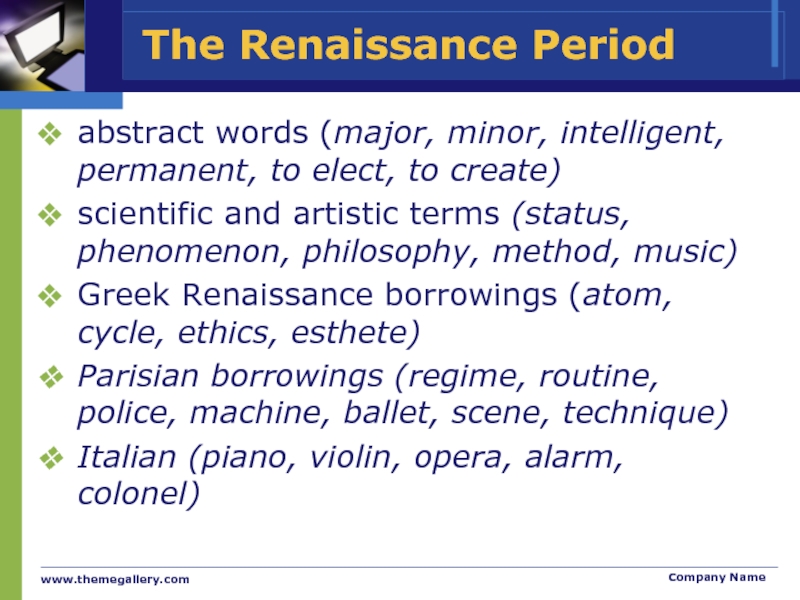
Слайд 18www.themegallery.com
Company Name
The Etymological Structure of English Vocabulary
The native element
Indo-European element
Germanic element
English Proper element (no earlier than 5th c. A.
D.)
The borrowed element
Celtic (5th — 6th c. A. D.)
Latin (1st group: 1st с. В. С. 2nd group: 7th c. A. D. 3rd group: the Renaissance period)
Scandinavian (8th — 11th c. A. D.)
French (1. Norman borrowings: 11th — 13th c. A. D. 2. Parisian borrowings (Renaissance))
Greek (Renaissance)
Italian, Spanish (Renaissance and later)
German, Indian, Russian and some other groups
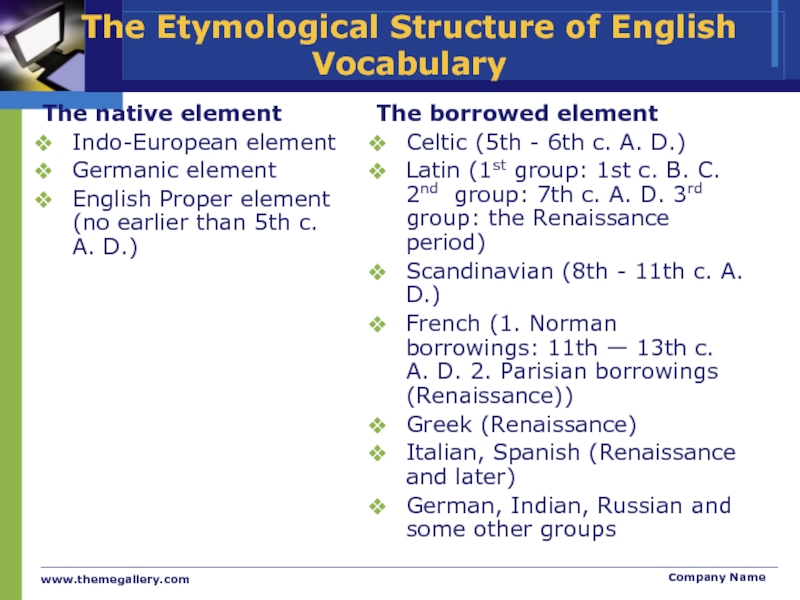
Слайд 19www.themegallery.com
Company Name
Indo-European element
Words of roots common to all or most
languages of the Indo-European group.
I. Family relations: father, mother,
brother, son, daughter.
II. Parts of the human body: foot, nose, lip, heart.
III. Animals: cow, swine, goose.
IV. Plants: tree, birch, corn
V. Time of day: day, night.
VI. Heavenly bodies: sun, moon, star.
VII. Numerous adjectives: red (cf. Ukr. рудий, R. рыжий), new, glad, sad.
VIII. The numerals from one to a hundred.
IX. Pronouns — personal (except they which is a Scandinavian borrowing); demonstrative.
X. Numerous verbs: be, stand, sit, eat, know.
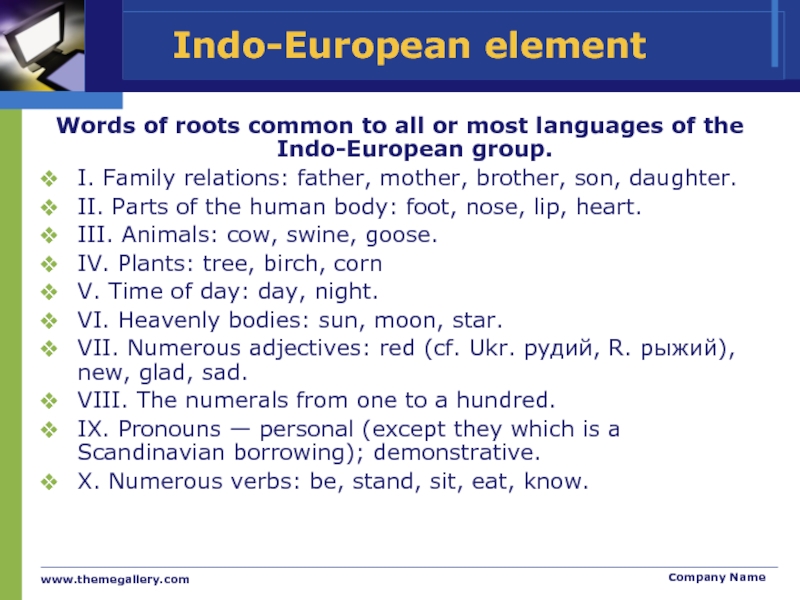
Слайд 20www.themegallery.com
Company Name
The Germanic element
Words of roots common to all or
most Germanic languages.
I. Parts of the human body: head,
hand, arm, finger, bone.
II. Animals: bear, fox, calf.
III.Plants: oak, fir, grass.
IV.Natural phenomena: rain, frost.
V. Seasons of the year: winter, spring, summer.
VI. Landscape features: sea, land.
VII. Human dwellings and furniture: house, room, bench.
VIII. Sea-going vessels: boat, ship.
IX. Adjectives: green, blue, grey, white, small, thick, high, old, good.
X. Verbs: see, hear, speak, tell, say, answer, make, give, drink.
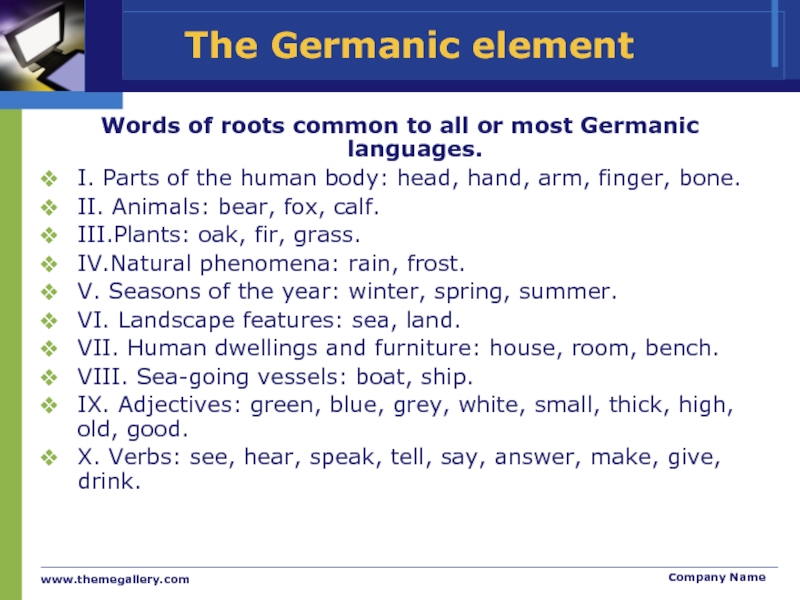
Слайд 21www.themegallery.com
Company Name
Star: Germ. Stern, Lat. Stella, Gr. aster.
Sad: Germ. satt,
Lat. satis, R. сыт, Snscr. sd-.
Stand: Germ. stehen, Lat. stare,
R. стоять, Snscr. stha-.
English proper words: bird, boy, girl, lord, lady, woman, daisy, always
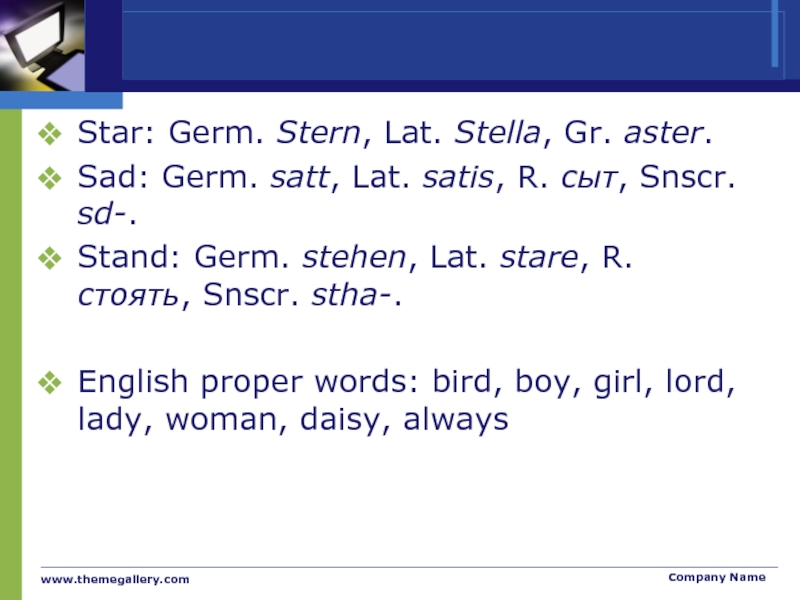
Слайд 22
4 main types of words can be
found in the English language:
Root words are words that have
only one root morpheme in their structure, e.g., boy, girl, pen, pencil, etc.
Derived words/ derivatives are words that have one root morpheme and one of several affixes in their structure, e.g. manhood, rewrite, unlike, etc.
Compound words are words that have 2 or more root morphemes in their structure starfish (+compound derivatives/ derivational compounds – built by composition in which one stem is derived, e.g., blue-eyed, old-timer, teenager, kind-hearted, etc.)
Shortenings/ contracted words are words formed by contracting certain elements of an existing word or word group, e.g., TV, exam, bus (omnibus), etc.
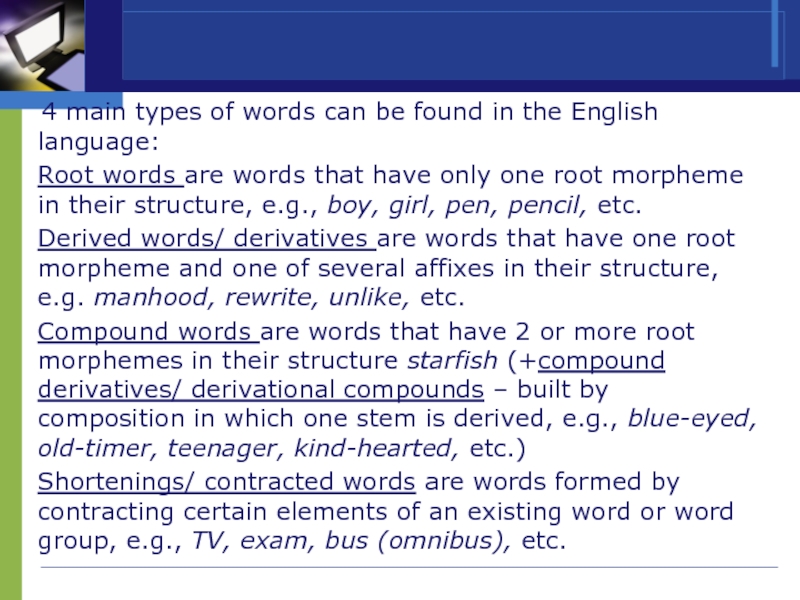
Слайд 23The most productive ways of word-building:
Conversion
e.g. water (n) -to water
(v); dry (adj) — to dry (v); must (v) —
a must (n), go (v) — a go (n).
Composition/ Compounding
Holiday(holy+day),breakthrough(break+through), bedroom (bed+room)
Derivation
The compound word ‘unkindness’ ‘kind’ is the base, un- the prefix and -ness the suffix; or in “disjoined’, “join’ is the base, dis- the prefix and -ed the suffix.
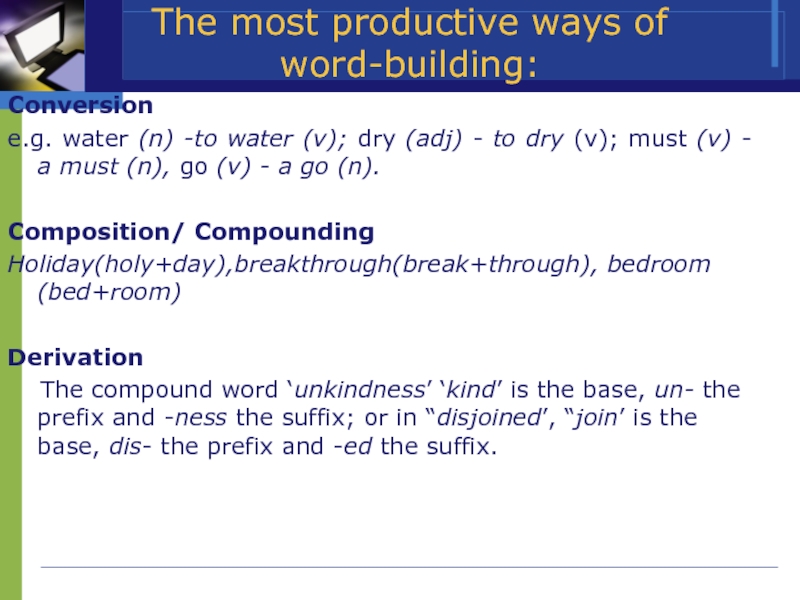
Слайд 24Homonyms
Homonyms proper (syn. absolute, perfect) – words identical in pronunciation
and spelling, e.g. temple – 1) висок, 2) храм; seal
– 1) печать, 2) тюлень; ball – 1) мяч, 2) бал, bark – 1) кора, 2) лай, etc.
Homophones – words identical in sound-form but different both in spelling and in meaning, e.g. to know – no, not – knot, to meet – meat, piece – peace, write – right, sea – see, son – sun, bye – buy – by, etc.
Homographs – words identical in spelling but different both in their sound-form and meaning, e.g. bow /bəʊ/ лук – /baʊ/ поклон, row /rəʊ/ ряд – /raʊ/ ссора, lead(v) /liːd/ вести – /lɛd/ свинец, tear (v) /tɛː/ рвать – /tɪə/ слеза, etc.
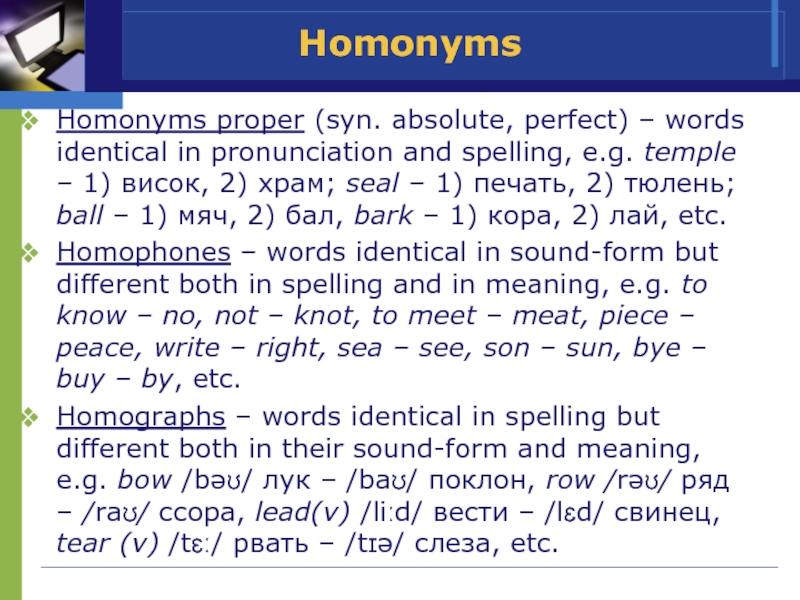
Слайд 25Semantic changes
Semantic change in the context of words describes the
gradual shift in the conventional meaning of words, as people
use them in new types of contexts and these usages become normal. The meaning of a word can change in the course of time. Transfer of the meaning is called lexico-semantic word-building. In such cases the outer aspect of a word does not change.
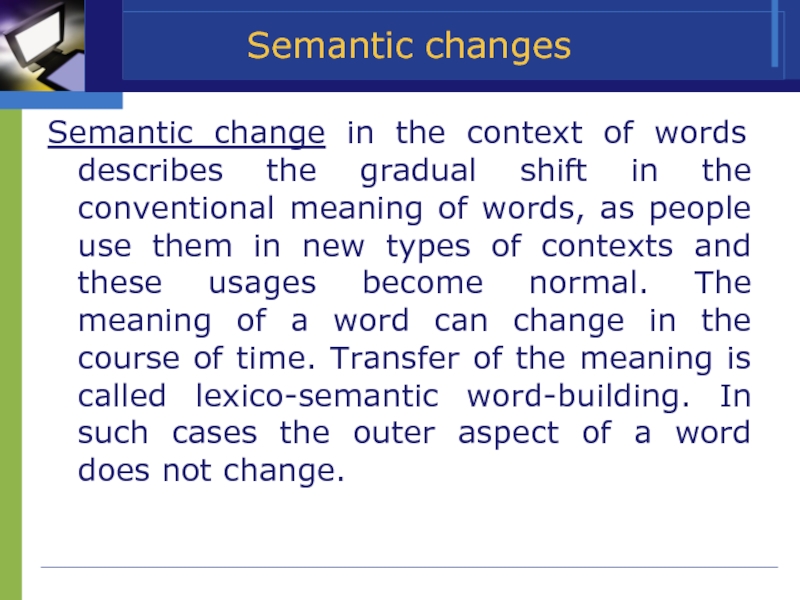
Слайд 26Types of semantic changes
Amelioration/əˌmiːlɪəˈreɪʃ(ə)n/ or elevation (a semantic shift of
meaning) e.g., pretty < OE: prættig ‘crafty, sly‘
Pejoration of
meaning (also degradation of meaning) e.g., spinster ‘unmarried woman’ < ‘one who spins’
Broadening (extension, generalization or widening) of meaning e.g., dog =>specific powerful breed of dog => all breeds or races of dog
Semantic narrowing of meaning (or specialization) e.g., wife => OE ‘woman’ =>’woman of humble rank or low employment’ => ‘married woman, spouse‘
Bleaching e.g., awfully, terribly, horribly (awfully late, awfully big, awfully small) or pretty (pretty good, pretty bad . . .)
Metaphor e.g., «The rain came down in long knitting needles.» (Enid Bagnold, National Velvet)
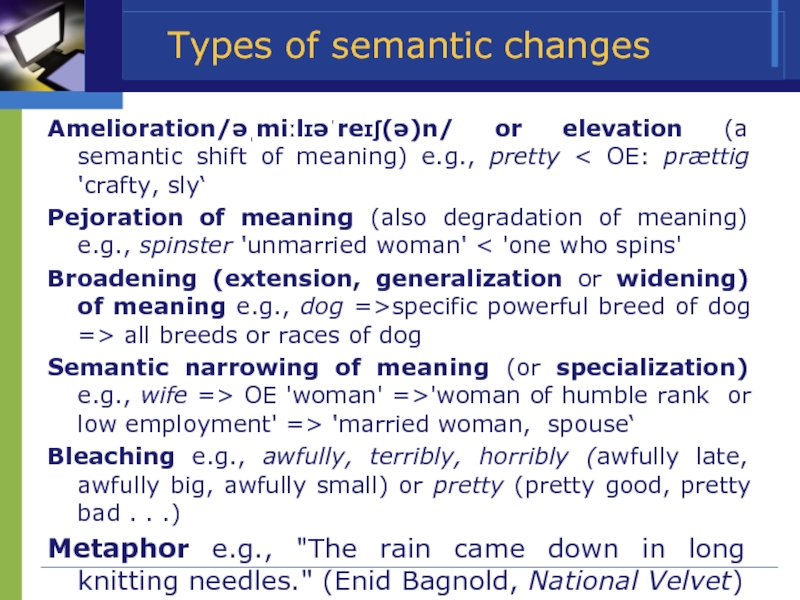
Слайд 27Types of semantic changes
Metonymy /mɪˈtɒnɪmi/ e.g., «Fear gives wings.» (Romanian
proverb)
Synecdoche / sɪˈnɛkdəki / e.g., hand ‘hired hand, employed
worker‘
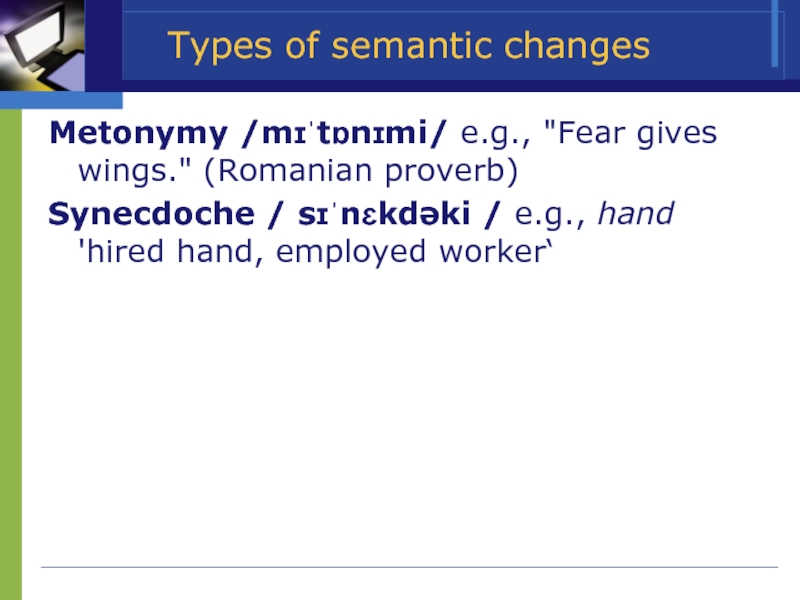
Слайд 28www.themegallery.com
Company Name
Exercises
Subdivide all the following words of native origin into:
a) Indo-european, b) Germanic, c) English proper.
Daughter, woman, room, land,
cow, moon, sea, red, spring, three, lady, always, goose, bear, fox, lord, tree, nose, daisy, heart
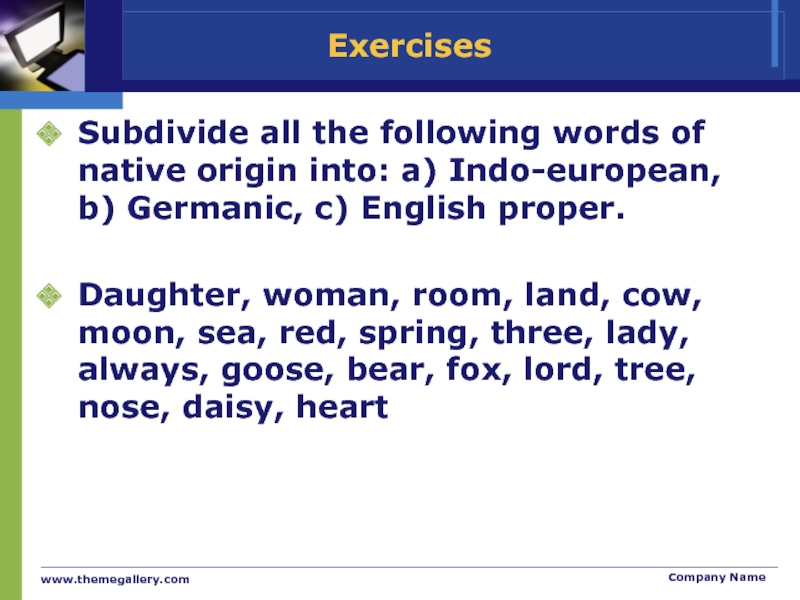
Слайд 29Exercises
Choose the correct answer.
A branch of lexicology which is devoted
to the study of meaning is called
a) Etymology
b) Dialectology
c) Semantics
d)
Phraseology
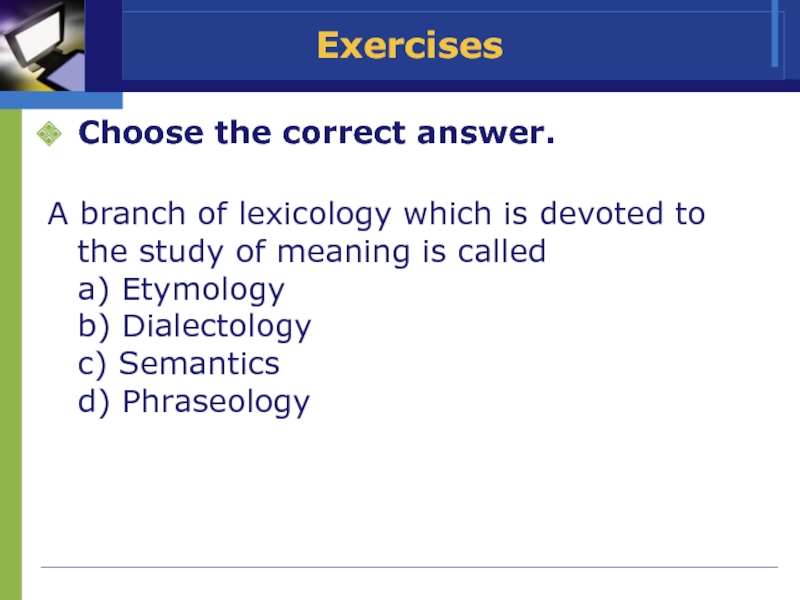
Слайд 30Exercises
Choose the correct answer.
The referential approach
a) seeks to formulate the
meaning by establishing the interdependence
between words and the things or
concepts they denote
b) studies the functions of a word in speech and is concerned with how
meaning works.
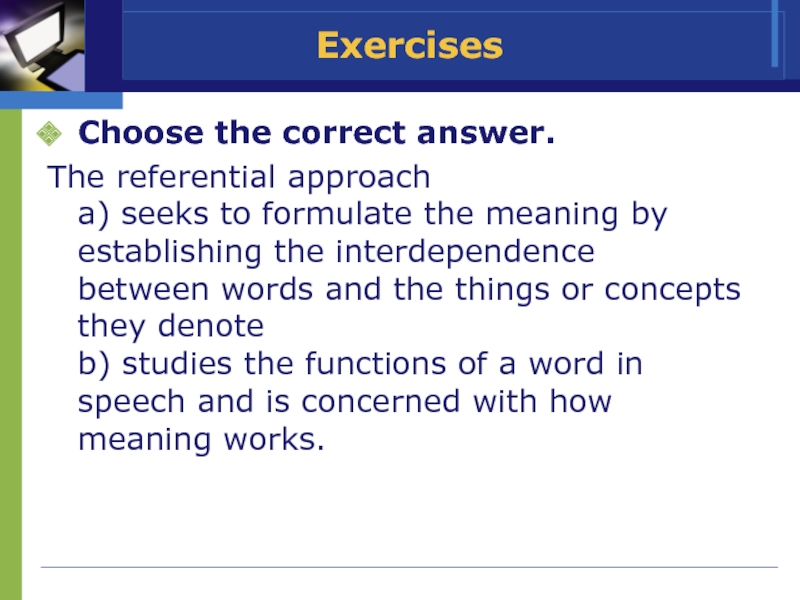
Слайд 31Choose the right answer.
1. She wants an apple, not a
___.
pear
pair
2. The bus ___ is one dollar.
fare
fair
3. ___ house is near the lake.
There
Their
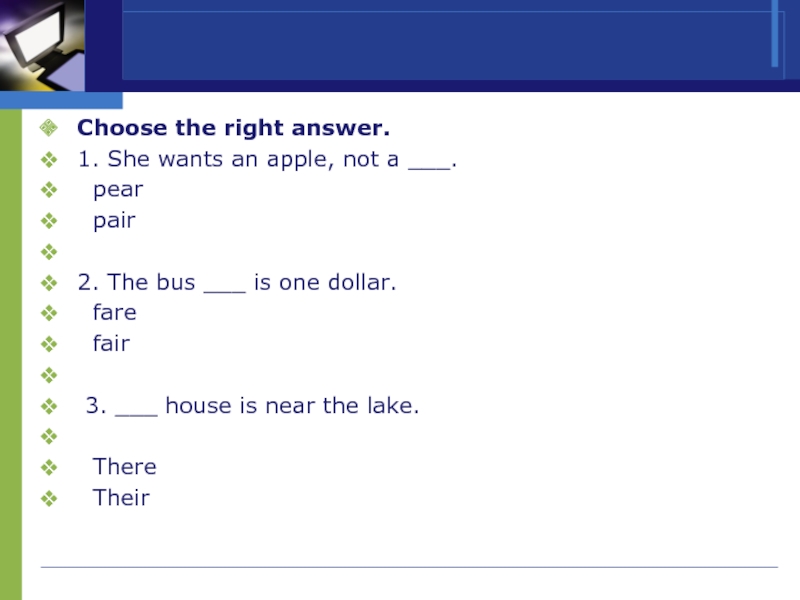
Слайд 324. No eating or drinking ___ on the sports ground!
aloud
allowed
5. The book teaches how to spell ___.
write
right
6. We took a ___ from work and went for a walk.
break
brake
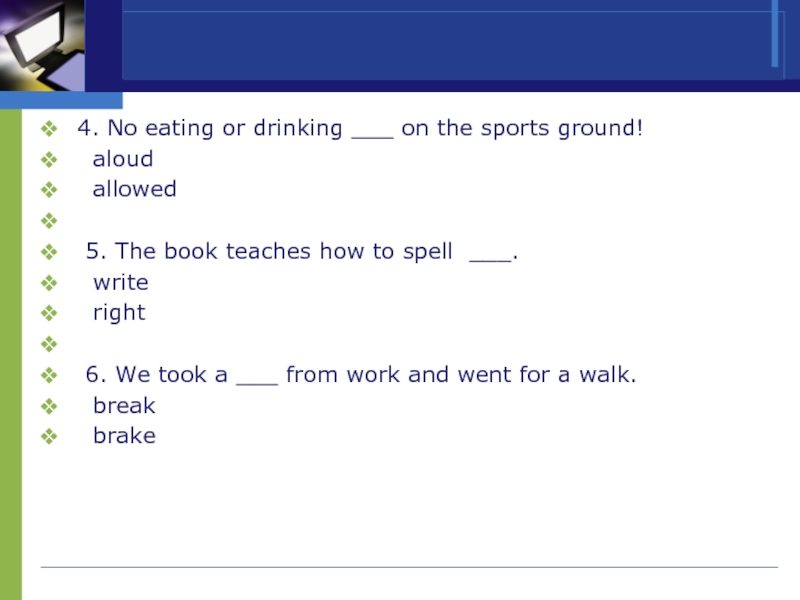
Слайд 33 7. We must consider this situation as a ___ .
hole
whole
8. It’s time to ___ the seeds.
sew
sow
9.
Mix some ___ with milk, eggs, and sugar and make cookies for the children.
flower
flour
10. It was more than I could ___ .
bare
bear
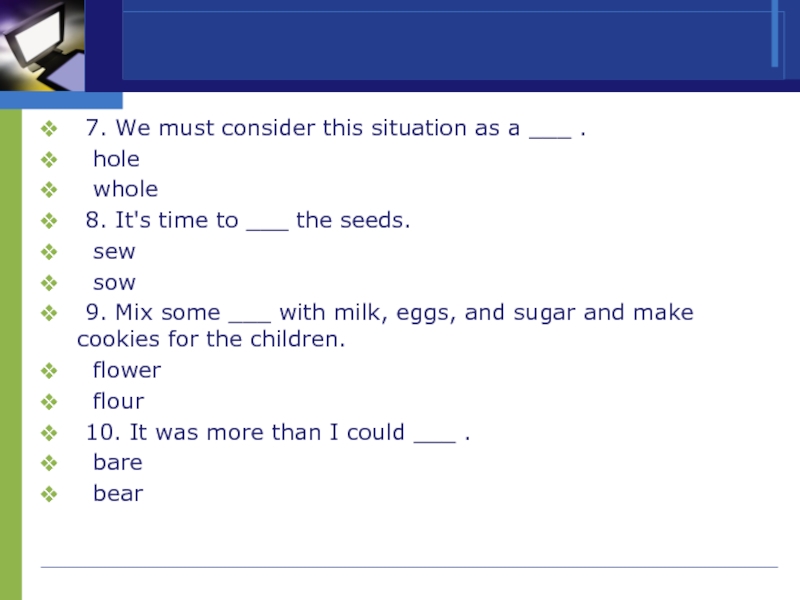
Слайд 34Semantic changes
1. Processes of Semantic Change
Identify the type of semantic
shift that has occurred in each case. Choose either Metaphor
or Metonymy.
a. barbecue ‘a rack for cooking meat over a fire’ > barbecue ‘a social event at which food is cooked over a fire’
b. influence ‘something which has flowed in’ > influence ‘something which affects someone without apparent effort’
c. mouth ‘the body opening through which an animal takes food’ > mouth ‘a person’ (eg. «three mouths to feed»)
d. solve ‘to loosen’ > solve ‘to clear up something puzzling’
e. counter ‘a device for counting’ > counter ‘a surface on which various devices can be placed’
f. mouth ‘the body opening through which an animal takes food’ > mouth ‘an opening into a cave or canyon’
g. white shirt ‘a shirt that is white in color’ > white shirt ‘a manager’
Слайд 35 2. Result of Semantic Change
For each example, tell whether
the result of the semantic shift is Narrowing, Degeneration, Widening,
or Amelioration.
a. OE wif ‘a woman’ > Modern English wife ‘a married woman’
b. nuke ‘to destroy with nuclear weapons’ > nuke ‘to destroy in any manner’
(eg. Buffy nuked her Porsche last night.)
c. ME marshall ‘groom for horses (literally ‘horse slave’)’ > Modern English marshall ‘high ranking officer’
d.OE steorfan ‘to die (of any cause)’ > Modern English starve ‘to die from hunger’
e. Middle English vilein ‘feudal serf, farmer’ > Modern English villain ‘a wicked or evil person’
f. OE bouchier ‘one who slaughters goats’ > Modern English butcher ‘one who slaughters animals’
g. Middle English girle ‘child’ > Modern English girl ‘female child’
h. lyric ‘poem to be sun with a lyre’ > lyric ‘any poem to be sung’
i. lewd ‘of the laity (i.e. non-church)’ > lewd ‘indecent’
j. OE mete ‘any food’ > Modern English meat ‘animal flesh’
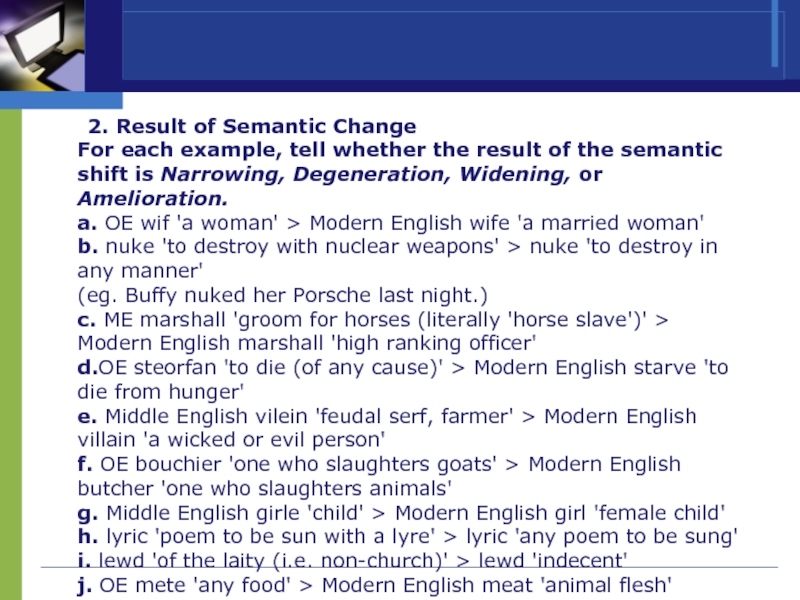
The Word As The Basic Unit Of The Language
The word is a unit of speech that serves the purposes of human communication. The word can be perceived as the total of the sounds which comprise it. The word, viewed structurally, possesses several characteristics.
Word-meaning Two schools: the referential approach, which seeks to formulate the essence of meaning by establishing the interdependence between words and the things or concepts they denote the functional approach, which studies the functions of a word in speech and is less concerned with what meaning is than with how it works

There is no inherent connection between this particular sound-cluster and the meaning of the word. English dove, Russian голубь Seal – “a piece of wax, lead” Seal – “a sea animal” O.E. lufian, Mn.E. love
Concept is a category of human cognition. Concept is the thought of the object that singles out its essential features. Our concepts abstract and reflect the most common and typical features of the different objects and phenomena of the world. Being the result of abstraction and generalisation all concepts are almost the same for the whole of humanity in one and the same period of its historical development.

Apple Fruit Something This
The structure of the word External structure (morphological) post-impressionists: prefixes post-, im- root press noun-forming suffixes -ion, -ist grammatical suffix of plurality –s Internal structure (semantic) The word’s meaning
The word’s unity
www.themegallery.com Company Name The Etymology of English Words
www.themegallery.com Company Name The first century В. С. butter and cheese (Lat. butyrum, caseus) cherry (Lat. Cerasum) pear (Lat. Pirum) pepper (Lat. Piper) plant (Lat. Planta) cup (Lat. cuppa) kitchen (Lat. coquina) port (Lat. portus) wine (Lat. vinum)
www.themegallery.com Company Name The fifth century A. D. Mod. E. bald, down, glen, druid, bard, cradle Avon, Exe, Esk, Usk, Ux Celtic Llyn + dun Street (Lat. strata via) Wall (Lat. Vallum)
www.themegallery.com Company Name The seventh century A. D. priest (Lat. presbyter) bishop (Lat. Episcopus) monk (Lat. monachus) nun (Lat. nonna) candle (Lat. candela) school (Lat. schola, of Greek origin) magister (Lat. magister)
www.themegallery.com Company Name End of the 8th –middle of the 11th Scandinavian borrowings: call, take, cast, die, law husband, (< Sc. hus + bondi, i. e. «inhabitant of the house»), window (< Sc. vindauga, i. e. «the eye of the wind») ill, loose, low, weak sky, skill, skin, ski, skirt О. Е. dream (“joy”) – Scandinavian draumr (Germ. Traum «dream“, R. дрёма)
www.themegallery.com Company Name 1066 Administrative words: state, government, parliament, council, power Legal terms: court, judge, justice, crime, prison Military terms: army, war, soldier, officer, battle, enemy Educational terms: pupil, lesson, library, science, pen, pencil table, plate, saucer, dinner, supper, river, autumn, uncle
www.themegallery.com Company Name The Renaissance Period abstract words (major, minor, intelligent, permanent, to elect, to create) scientific and artistic terms (status, phenomenon, philosophy, method, music) Greek Renaissance borrowings (atom, cycle, ethics, esthete) Parisian borrowings (regime, routine, police, machine, ballet, scene, technique) Italian (piano, violin, opera, alarm, colonel)
www.themegallery.com Company Name The Etymological Structure of English Vocabulary The native element Indo-European element Germanic element English Proper element (no earlier than 5th c. A. D.) The borrowed element Celtic (5th — 6th c. A. D.) Latin (1st group: 1st с. В. С. 2nd group: 7th c. A. D. 3rd group: the Renaissance period) Scandinavian (8th — 11th c. A. D.) French (1. Norman borrowings: 11th — 13th c. A. D. 2. Parisian borrowings (Renaissance)) Greek (Renaissance) Italian, Spanish (Renaissance and later) German, Indian, Russian and some other groups
www.themegallery.com Company Name Indo-European element Words of roots common to all or most languages of the Indo-European group. I. Family relations: father, mother, brother, son, daughter. II. Parts of the human body: foot, nose, lip, heart. III. Animals: cow, swine, goose. IV. Plants: tree, birch, corn V. Time of day: day, night. VI. Heavenly bodies: sun, moon, star. VII. Numerous adjectives: red (cf. Ukr. рудий, R. рыжий), new, glad, sad. VIII. The numerals from one to a hundred. IX. Pronouns — personal (except they which is a Scandinavian borrowing); demonstrative. X. Numerous verbs: be, stand, sit, eat, know.
www.themegallery.com Company Name The Germanic element Words of roots common to all or most Germanic languages. I. Parts of the human body: head, hand, arm, finger, bone. II. Animals: bear, fox, calf. III.Plants: oak, fir, grass. IV.Natural phenomena: rain, frost. V. Seasons of the year: winter, spring, summer. VI. Landscape features: sea, land. VII. Human dwellings and furniture: house, room, bench. VIII. Sea-going vessels: boat, ship. IX. Adjectives: green, blue, grey, white, small, thick, high, old, good. X. Verbs: see, hear, speak, tell, say, answer, make, give, drink.
www.themegallery.com Company Name Star: Germ. Stern, Lat. Stella, Gr. aster. Sad: Germ. satt, Lat. satis, R. сыт, Snscr. sd-. Stand: Germ. stehen, Lat. stare, R. стоять, Snscr. stha-. English proper words: bird, boy, girl, lord, lady, woman, daisy, always
4 main types of words can be found in the English language: Root words are words that have only one root morpheme in their structure, e.g., boy, girl, pen, pencil, etc. Derived words/ derivatives are words that have one root morpheme and one of several affixes in their structure, e.g. manhood, rewrite, unlike, etc. Compound words are words that have 2 or more root morphemes in their structure starfish (+compound derivatives/ derivational compounds – built by composition in which one stem is derived, e.g., blue-eyed, old-timer, teenager, kind-hearted, etc.) Shortenings/ contracted words are words formed by contracting certain elements of an existing word or word group, e.g., TV, exam, bus (omnibus), etc.
The most productive ways of word-building: Conversion e.g. water (n) -to water (v); dry (adj) — to dry (v); must (v) — a must (n), go (v) — a go (n). Composition/ Compounding Holiday(holy+day),breakthrough(break+through), bedroom (bed+room) Derivation The compound word ‘unkindness’ ‘kind’ is the base, un- the prefix and -ness the suffix; or in “disjoined’, “join’ is the base, dis- the prefix and -ed the suffix.
Homonyms Homonyms proper (syn. absolute, perfect) – words identical in pronunciation and spelling, e.g. temple – 1) висок, 2) храм; seal – 1) печать, 2) тюлень; ball – 1) мяч, 2) бал, bark – 1) кора, 2) лай, etc. Homophones – words identical in sound-form but different both in spelling and in meaning, e.g. to know – no, not – knot, to meet – meat, piece – peace, write – right, sea – see, son – sun, bye – buy – by, etc. Homographs – words identical in spelling but different both in their sound-form and meaning, e.g. bow /bəʊ/ лук – /baʊ/ поклон, row /rəʊ/ ряд – /raʊ/ ссора, lead(v) /liːd/ вести – /lɛd/ свинец, tear (v) /tɛː/ рвать – /tɪə/ слеза, etc.
Semantic changes Semantic change in the context of words describes the gradual shift in the conventional meaning of words, as people use them in new types of contexts and these usages become normal. The meaning of a word can change in the course of time. Transfer of the meaning is called lexico-semantic word-building. In such cases the outer aspect of a word does not change.
Types of semantic changes Amelioration/əˌmiːlɪəˈreɪʃ(ə)n/ or elevation (a semantic shift of meaning) e.g., pretty < OE: prættig ‘crafty, sly‘ Pejoration of meaning (also degradation of meaning) e.g., spinster ‘unmarried woman’ < ‘one who spins’ Broadening (extension, generalization or widening) of meaning e.g., dog =>specific powerful breed of dog => all breeds or races of dog Semantic narrowing of meaning (or specialization) e.g., wife => OE ‘woman’ =>’woman of humble rank or low employment’ => ‘married woman, spouse‘ Bleaching e.g., awfully, terribly, horribly (awfully late, awfully big, awfully small) or pretty (pretty good, pretty bad . . .) Metaphor e.g., «The rain came down in long knitting needles.» (Enid Bagnold, National Velvet)
Types of semantic changes Metonymy /mɪˈtɒnɪmi/ e.g., «Fear gives wings.» (Romanian proverb) Synecdoche / sɪˈnɛkdəki / e.g., hand ‘hired hand, employed worker‘
www.themegallery.com Company Name Exercises Subdivide all the following words of native origin into: a) Indo-european, b) Germanic, c) English proper. Daughter, woman, room, land, cow, moon, sea, red, spring, three, lady, always, goose, bear, fox, lord, tree, nose, daisy, heart
Exercises Choose the correct answer. A branch of lexicology which is devoted to the study of meaning is called a) Etymology b) Dialectology c) Semantics d) Phraseology
Exercises Choose the correct answer. The referential approach a) seeks to formulate the meaning by establishing the interdependence between words and the things or concepts they denote b) studies the functions of a word in speech and is concerned with how meaning works.
Choose the right answer. 1. She wants an apple, not a ___. pear pair 2. The bus ___ is one dollar. fare fair 3. ___ house is near the lake. There Their
4. No eating or drinking ___ on the sports ground! aloud allowed 5. The book teaches how to spell ___. write right 6. We took a ___ from work and went for a walk. break brake
7. We must consider this situation as a ___ . hole whole 8. It’s time to ___ the seeds. sew sow 9. Mix some ___ with milk, eggs, and sugar and make cookies for the children. flower flour 10. It was more than I could ___ . bare bear
Semantic changes 1. Processes of Semantic Change Identify the type of semantic shift that has occurred in each case. Choose either Metaphor or Metonymy. a. barbecue ‘a rack for cooking meat over a fire’ > barbecue ‘a social event at which food is cooked over a fire’ b. influence ‘something which has flowed in’ > influence ‘something which affects someone without apparent effort’ c. mouth ‘the body opening through which an animal takes food’ > mouth ‘a person’ (eg. «three mouths to feed») d. solve ‘to loosen’ > solve ‘to clear up something puzzling’ e. counter ‘a device for counting’ > counter ‘a surface on which various devices can be placed’ f. mouth ‘the body opening through which an animal takes food’ > mouth ‘an opening into a cave or canyon’ g. white shirt ‘a shirt that is white in color’ > white shirt ‘a manager’
2. Result of Semantic Change For each example, tell whether the result of the semantic shift is Narrowing, Degeneration, Widening, or Amelioration. a. OE wif ‘a woman’ > Modern English wife ‘a married woman’ b. nuke ‘to destroy with nuclear weapons’ > nuke ‘to destroy in any manner’ (eg. Buffy nuked her Porsche last night.) c. ME marshall ‘groom for horses (literally ‘horse slave’)’ > Modern English marshall ‘high ranking officer’ d.OE steorfan ‘to die (of any cause)’ > Modern English starve ‘to die from hunger’ e. Middle English vilein ‘feudal serf, farmer’ > Modern English villain ‘a wicked or evil person’ f. OE bouchier ‘one who slaughters goats’ > Modern English butcher ‘one who slaughters animals’ g. Middle English girle ‘child’ > Modern English girl ‘female child’ h. lyric ‘poem to be sun with a lyre’ > lyric ‘any poem to be sung’ i. lewd ‘of the laity (i.e. non-church)’ > lewd ‘indecent’ j. OE mete ‘any food’ > Modern English meat ‘animal flesh’
Федеральное агентство по образованию Государственное образовательное учреждение высшего профессионального образования Тульский государственный университет Кафедра лингвистики и перевода
Лекции по лексикологии английского языка
для студентов, обучающихся по направлению 031100 – лингвистика и перевод
по специальности 031202 – перевод и переводоведение
Автор: кандидат филологических наук, доцент Гусева Галина Владимировна
Тула 2007
Lecture 1
What is Lexicology?
I.The Subject of Lexicology
The term lexicology is of Greek origin (from lexis – word and logos — science). Lexicology is the part of linguistics which deals with the vocabulary and characteristic features of words and word-groups.
The term word denotes the main lexical unit of a language resulting from the association of a group of sounds with a meaning. This unit is used in grammatical functions characteristic of it. It is the smallest unit of a language which can stand alone as a complete utterance.
The term word-group denotes a group of words which exists in the language as a ready-made unit, has the unity of meaning, the unity of syntactical function, e.g. the word-group as loose as a goose means clumsy and is used in a sentence as a predicative (He is as loose as a goose).
Lexicology can be general and special. General lexicology is the lexicology of any language, part of General Linguistics. It is aimed at establishing language universals – linguistic phenomena and propeties common to all languages.
Special lexicology is the lexicology of a particular language (English, German, Russian, etc.).
Lexicology can study the development of the vocabulary, the origin of words and word-groups, their semantic relations and the development of their sound form and meaning. In this case it is called historical lexicology.
Another branch of lexicology is called descriptive and studies the vocabulary at a definite stage of its development.
II.What is a Word?
First, the word is a unit of speech which, as such, serves the purposesof human communication. Thus, the word can be defined as a unit of communication.
Secondly, the word can be perceived as the total of the sounds which comprise it.
Third, the word, viewed structurally, possesses several characteristics.
The modern approach to word studies is based on distinguishing between the external and the internal structures of the word.
By external structure of the word we mean its morphological structure. For example, in the word post-impressionists the following morphemes can be distinguished: the prefixes post-, im-, the root press, the noun-forming suffixes – ion, -ist, and the grammatical suffix of plurality –s.
The external structure of the word, and also typical word-formation patterns, are studied in the framework of word-building.
The internal structure of the word, or its meaning, is nowadays commonly referred to as the word‘s semantic structure. This is the word‘s main aspect.
The area of lexicology specialising in the semantic studies of the word is called semantics.
One of the main structural features of the word that it possesses both external (formal) unity and semantic unity.
A further structural feature of the word is its susceptibility to grammatical employment. In speech most words can be used in different grammatical forms in which their interrelations are realized.
Thus, the word is a speech unit used for the purposes of human communication, materially representing a group of sounds, possessing a meaning, susceptible to grammatical employment and characterized by formal and semantic unity.
III.The Problem of Word-Boundaries
The difference between words and other two-facet units is not always clear. There are:
1.Form words. On the one hand, they fuse with notional words phonetically and do not function as sentence-members. On the other hand, they are positionally mobile, e.g. a, to, and.
2.Loose compounds, e.g. speech sound, stone wall. On the one hand, theya are built in speech. On the other hand, they have one lexical stress.
3.Phrasal words: his I-love-you‘s. On the one hand, they are built in speech and
are not reproducible. On the other, they have one lexical stress.
The difference between variants of the same word and different words is also not always clear. Within the language system the word is a lexeme – an abstract unit which unites all its variant:
a)lexico-semantic variants – different meanings of the same polysemantic word: to give a pen, to give a smile, to give an answer;
b)phonetic variants – different pronouncation of the same word: neither, either, often;
c)orthographic variants – different spelling of the same word: jail – gaol;
d)morphological variants – different morphemic structure of the same word: learned – learnt, geographic – geographical.
IV. Lexicology and its Connection with Other Linguistc Disciplines
Lexicology is closely connected with other branches of linguistcs:
1.It is connected with Phonetics because the word‘s sound form is a fixed sequence of phonemes united by a lexical stress.
2.Lexicology is connected with Morphology and Word-Formation as the word‘s structure is a fixed sequence of morphemes.
3.It is connected with Morphology because the word‘s content plane is a unity of lexical and grammatical meanings.
4.The word functions as part of the sentence and performs a certain syntactical function that is why it is also connected with Syntax.
5.The word functions in different situations and spheres of life therefore it is connected with Stylistics, Socioand Psycholinguistics.
But there is also a great difference between lexicology and other linguistc disciplines. Grammatical and phonological systems are relatively stable. Therefore they are mostly studied within the framework of intralinguistics.
Lexical system is never stable. It is directly connected with extralinguistic systems. It is constantly growing and decaying. It is immediately reacts to changes in social life, e.g. the intense development of science and technology in the 20th century gave birth to such words as computer, sputnik, spaceship. Therefore lexicology is a sociolinguistic discipline. It studies each particular word, both its intraand extralingiustic relations.
Lexicology is subdivided into a number of autonomous but interdependent disciplines:
1.Lexicological Phonetics. It studies the expression plane of lexical units in isolation and in the flow of speech.
2.Semasiology. It deals with the meaning of words and other linguistic units: morphemes, word-formation types, morphological word classes and morphological categories.
3.Onomasiology or Nomination Theory. It deals with the process of nomination: what name this or that object has and why.
4.Etymology. It studies the origin, the original meaning and form of words.
5.Praseology. It deals with phraseological units.
6.Lexicography. It is a practical science. It describes the vocabulary and each lexical unit in the form of dictionaries.
7.Lexical Morphology. It deals with the morphological stricture of the word.
8. Word-formation. It deals with the patterns which are used in coining new words.
Lecture II
Meaning. Concept
I.Approaches to Lexical Meaning
There are two main approaches to lexical meaning: referential and functional. The referential approach studies the connection between words and thins or concepts they denote. Functional approach studies relations between words.
The referential model of meaning is the so-called basic semantic triangle. it consists of:
1.The sound-form (Sign) of the word: [bз:d].
2.The referent (Denotatum) – the object which the word names: the actual bird.
3.The concept (Designatum) – The essential properties of this object which are reflected in human mind: “a feathered anial with wings“.
Meaning is closely connected with all parts of the semantic triangle but cannot be equated with any of them. Generally speaking, meaning can be described as a component of the word through which a concept is communicated, in this way endowing the word with the ability of denoting real objects, qualities, actions and absract notions.
The functional approach assumes that the meaning of a linguistic unit can be studied only through its relation to other linguistic units and not through its relation to concept or referent, e.g. we know that the meaning of “bird n“ and “bird v“ is different because they function in speech differently. Analysing various contexts in which these words are used we can observe that they have different distribution. As the distribution of the two words is different, their meanings are different too.
The same is true of a polysemantic word: Look at me – You look tired. Consequently, semantic investigation is confined to the analysis of the difference or sameness of meaning. the functional approach is a valuable complement to the referential theory.
II.Lexical Meaning and Concept
Meaning and concept are very closely associated but not identical. Meaning is a linguistic category. Concept is a logical and psychological category, a unit of thinking.
Meaning and concept coincide only in scientific terms that have no general meanings (morpheme, phoneme, amoeba) and in terminilogical meanings of polysemantic words, e.g. legal, medical or grammatical usages of the word case. In other aspects meaning and concept do not coincide:
1.Concept is emotionally and stylistically neutral. Meaning may include non-conceptual parts: kid, gorgeous, birdie.
2.One and the same concept can be expressed differently: die – pass away, kick the bucket.
3.The number of concepts does not correspond to the number of words and meanings. One concept may be expressed by several synonymous words: child, kid – infant. One polysemantic word may express several concepts: draw – “move by pulling“ (draw a boat out of the water), “obtain from a source“ (draw water from a well), “make with a pen, pencil or chalk“ (draw a straight line). Some words do not express concepts at all: well, must, perhaps.
4.Concepts are mostly international. Meanings are nationally specific. Words expressing identical concepts may have different meanings and different semantic structures in different languages: house – дом; blue —
синий, голубой.
III. Types of Lexical Meaning
The content plane of words includes denotative and connotative meanings. Denotative or referential meaning, the basic type of lexical meaning, is the
word‘s reference to the object. This reference may be individual (The dog is trained) or general (It‘s not a dog). That is why denotative meaning is subdivided into demonstrative and significative.
The type of denotative meaning varies in different groups of words.
The meaning of situational words is relative – it depends on the situation and context: here, son, my, this, now.
Pronominal words do not name the referent, they only point to it: he, she, they. Their meaning in isolation is very general: he – any male. but in speech their reference is always individual: he – this particular male.
The referent of proper names is always an individual object or person. They refer to each member of a particular class: London, Paris (cities), John, Bob (men).
Specific and generic terms differ in the size of the referent group: rose – flower; flower – plant. General terms have a wider meaning and can substitute for any specific term: dog – English bulldog, French poodle, cocker spaniel.
The referent of abstract words can be perceived by the mind and not by the senses: miracle, polite, to manage.
Connotative meaning includes various additional meanings: emotional, evaluative intensifying and expressive, e.g. hillock, to devour. As a rule, connotation co-exists with denotation. However, sometimes it comes to the fore and weakens the word‘s denotative meaning.
Words also may have a certain stylistic value. It means that they refer to this or that situation or functional style: science, everyday life, business: get – obtain – procure; child – kid – infant.
IV. Lexical and Grammatical Meaning
The word is a lexical-grammatical unity. Its content plane includes two types of meaning: lexical and grammatical.
Lexical meaning is individual, unique. It does not belong to any other word in the same language: bicycle – a vehicle with two wheels, handle-bars to guide it with, a seat, and two pedals to make it go. Grammatical meaning is general, standard. It belongs to a whole class of words and word-forms: bicycle – a noun in the common case, singular.
At the same time lexical and grammatical meanings co-exist in the word and are interdependent:
1.Lexical meaning affects grammatical meaning: abstract or mass nouns have no plural form (joy, sugar), relative adjectives have no degrees of comparison (watery), statal verbs are not used in progressive tenses (see, understand).
2.Grammatical meaning affects lexical meaning. Different meanings of the polysemantic word go have their own grammatical peculiarities: He has gone to China – moved (go + adverb of place); They are going to get married soon – are planning (be going + to-infinitive); The children went wild with eycitement – became (go + adjective).
3.Combinability of the word depends both on its lexical and grammatical (part-of-speech) meaning, e.g. the noun tea combines with strong but not with strongly.
4.Grammatical form may be isolated from the paradigm and become lexicalized: works – factory.
5.Lexical meaning may be grammaticalized, e.g. some notional verbs may be used as link-verbs: give a smile, turn red.
Lecture III
Semantic Changes
I.The Causes of Semantic Changes
The meaning of a word can change in the course of time. Transfer of the meaning is called lexico-semantic word-building. In such cases the outer aspect of a word does not change.
The causes of semantic changes can be extra-linguistic and linguistic: the change of the lexical meaning of the noun pen was due to extra-longuistic causes. Primarily pen comes back to the latin word penna (a feather of a bird). As people wrote with goose pens the name was transferred to steel pens which were later on used for writing. Still later any instrument for writing was called a pen.
On the other hand, causes may be linguistic, e.g. the conflict of synonyms when a perfect synonym of a native word is borrowed from some other language one of them may specialize in its meaning. The noun tide in Old English was polysemantic and denoted time, season, hour. When the French words time, season, hour were borrowed into English they ousted the word tide in these meanings. It was specialized and now means regular rise and fall of the sea caused by attraction of the moon. The meaning of a word can also change due to ellipsis: the word-group a train of carriages had the meaning of a row of carriages, later on of carriages was dropped and the noun train changed its meaning, it is used now in the function and with the meaning of the whole word-group.
Semantic changes have been classified by different scientists. The most complete classification was suggested by a German scientist Herman Paul. It is based on the logical principle. He distinguishes two main ways where the semantic change is gradual (specialization and generalization), two momentary conscious
Соседние файлы в предмете [НЕСОРТИРОВАННОЕ]
- #
- #
- #
- #
- #
- #
- #
- #
- #
- #
- #

































